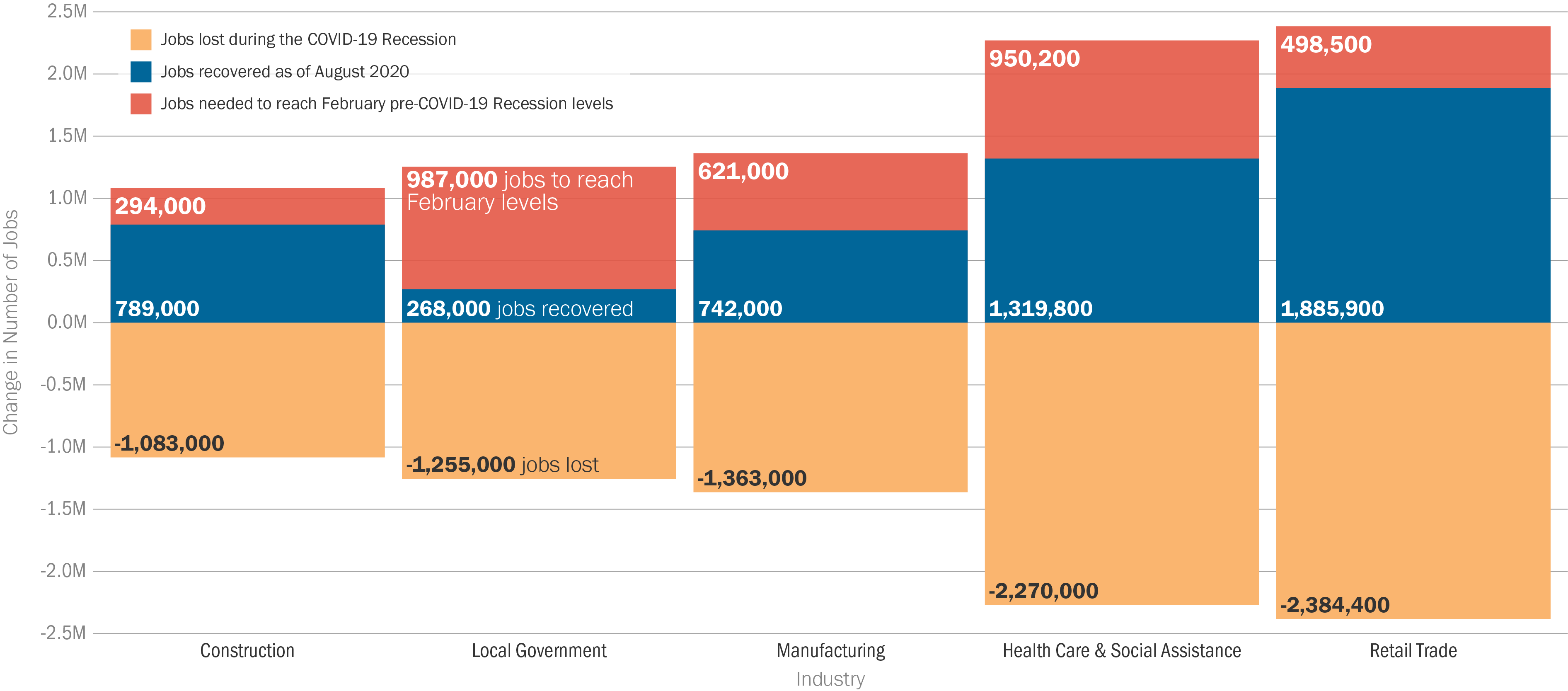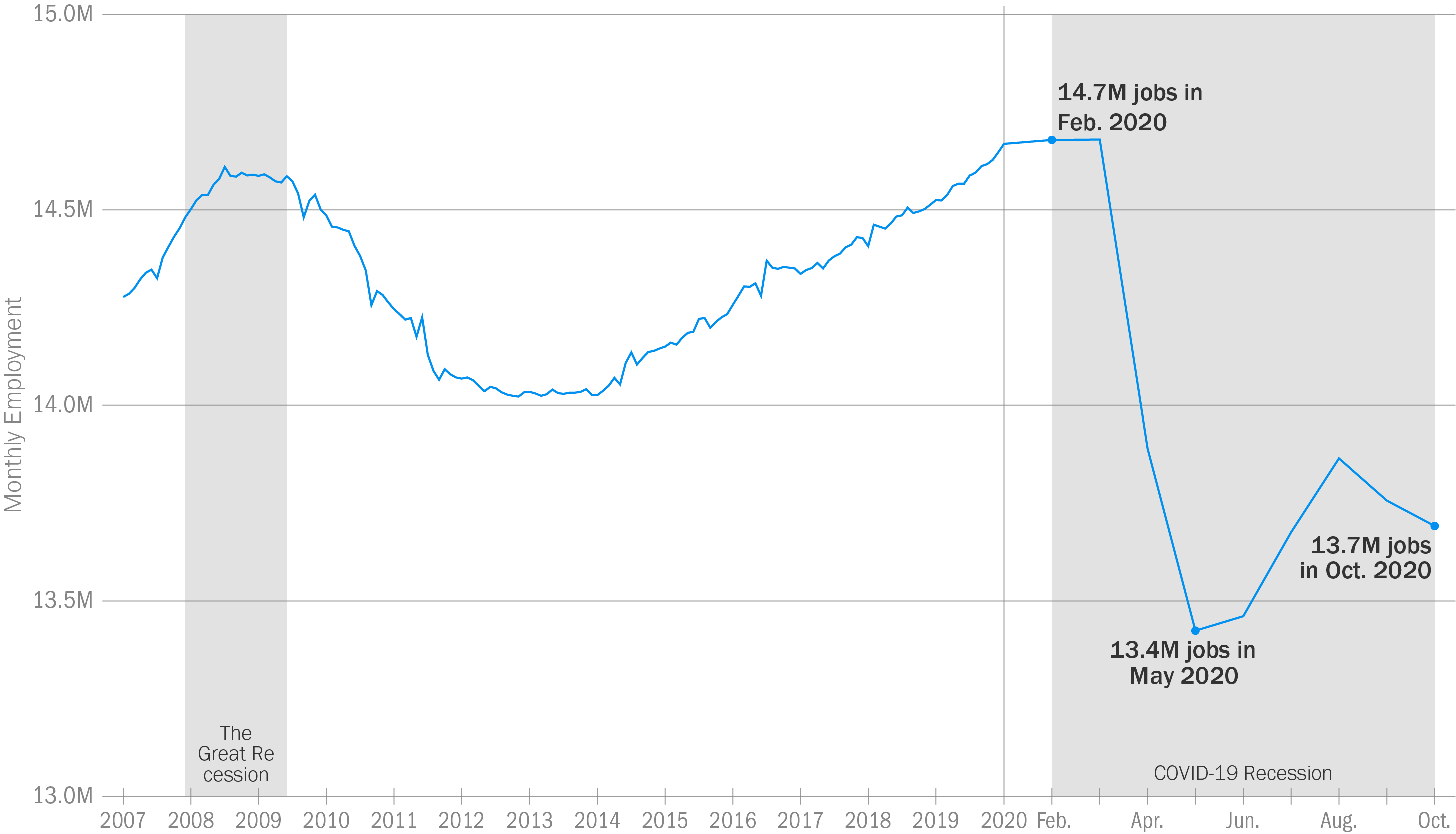Key Takeaways
- The unemployment rate decreased 1 percentage point between September and October, continuing to mark the recovery in the labor market from the COVID-19 recession.
- Local government education related employment lost 97,800 jobs, while non-education jobs rose a nominal 33,300 creating a net decrease of 65,000 local government jobs in October.
- Unemployment rates decreased for every major demographic group such as race, sex and age groups.
- Temporary layoffs decreased by 1.4 M in October, down significantly from its April high of 18.1 million and 2.4 million higher in February.
- The labor force participation rate increased by 0.3 percentage points in October, indicating workers may be gaining some confidence in the job market.
- Local governments are in need of additional direct and flexible federal aid to avoid further layoffs and foster the rebuilding of local communities.
|
A rose-colored October employment situation report reveals additional positive news for the economy – except for the public sector. The national unemployment rate decreased by 1 percentage point between September and October as nonfarm payroll increased by 638,000 jobs, marking the sixth month of consecutive declines in the unemployment rate. However, the continued declines in the government sector, specifically local government, ignite concerns as counties continue to support community recovery, securing services like broadband for residents, administering elections and a plethora of other services with less human resources.
UNEMPLOYMENT RATE EXPERIENCES DECREASE IN OCTOBER, NOW TWO TIMES THAT OF FEBRUARY LEVELS
U.S. unemployment rate, 2007- Oct. 2020
Though October marked another improvement in the labor market conditions, the unemployment rate remains higher than February levels, now only 3.4 percentage points higher. Additionally, unemployment rates declined for every race, sex and age group in October, but all remain above February levels. One contribution to the decrease in unemployment is the labor force participation rate, which increased by .3 percentage points in October. Though labor force participation is still lower than February, increases signal workers are regaining some faith in the ability to pursue employment. Most private employment sectors also experienced gains in October.
LOCAL GOVERNMENT EMPLOYMENT NOW 987,000 JOBS SHORT OF FEBRUARY LEVELS, WORSENING AFTER OCTOBER JOB LOSS
Change in employment by selected industries, Feb.- Oct. 2020

Significant job gains occurred in October in select industries such as leisure and hospitality, retail trade, construction and professional & business services.
- The leisure and hospitality sector gained 271,000 jobs in October but remains 3.5 M jobs below February levels
- Professional and business services added 208,000 jobs, now only 1.1 M jobs below February levels
- Retail trade employment levels increased 104,000 in October and is closing in on February levels with only 404,000 jobs left before parity
- The construction sector gained 84,000 jobs in October, now a marginal 294,000 jobs below February levels
- With 950,000 fewer jobs than in February, the health care and social assistance sectors only increased by 79,000 jobs
- Transportation and warehousing experienced 63,000 jobs in October, now 271,000 jobs below February levels
- Other services gained 47,000 jobs in October, now 436,000 below February levels
- October manufacturing employment increased by 38,000 jobs, however, remains 621,000 jobs lower than February levels
- Financial activities experienced job additions of 31,000 and is now 129,000 jobs lower than February levels
Other major industries experienced minor changes in employment levels in October, but all remain lower than February levels. As recovery continues, many of these key industries will continue to close the gap between pre-recession February job levels and current levels.
ADDITIONAL LOCAL GOVERNMENT JOB LOSS IN OCTOBER, AGAIN DRIVEN BY EDUCATION RELATED JOB LOSS
Change in employment by government type, Feb.- Oct. 2020
The public sector did not experience the positive job gains exemplified in the private sector October figures. Federal, state and local governments all saw job declines in October. Federal government job declines were reportedly driven by a loss of 147,000 Census workers. Despite the job loss experienced in October, the Federal government sector reportedly has 126,000 more jobs in October than in February. State and local government job losses are the result of significant job declines in education-related employment despite October falling in the middle of school semesters. Though local government non-education employment did increase by about 33,300 jobs, education-related employment for local government lost about 97,800 jobs in October. This resulted in a net decrease of about 65,000 jobs in local government during October.
LOCAL GOVERNMENT EXPERIENCES ANOTHER MONTH OF JOB LOSS IN OCTOBER
Local Government Employment, 2007 - Oct. 2020

Local government employment has now decreased in 4 of the 6 months following the peak of the COVID-19 recession in April. Healthy local government employment is important to community economic recovery. Counties are driving initiatives to support broadband access, administering elections at the local, state and federal levels, and providing other key services to residents. With declining employment in these areas, local governments will be forced to become increasingly agile in resource allocation while still maintaining the high level of service community residents rely upon.
TEMPORARY LAYOFFS DECREASE IN OCTOBER, PERMANENT JOB LOSS HOLDS STEADY
Total number of unemployed workers on temporary layoff vs. not on temporary layoff, Feb. - Oct. 2020
Nationally, the number of people on temporary layoff decreased by 1.4 M in October, for a total of about 3.2 M individuals. The steady decline in this measure from the peak in April of 18.1 M coincides with the additional positive national economic news in October. However, the measure is still ringing in 2.4 M higher than February levels. On the other hand, permanent job losers had little movement in the October employment situation, now a total of 2.4 M higher than February levels. Tangential measures of the number of long-term unemployed individuals increased by 1.2 M, now at 3.6 M. According to the Bureau of Labor Statistics, this measure makes up 32.5 percent of those unemployed.
THE IMPACT OF COVID-19 ON THE LABOR MARKET LANDSCAPE
The COVID-19 pandemic is still taking its toll on the employment landscape. In October, the number of individuals who were employed in a part-time status due to economic reasons increased by 383,000, now at 6.7 million. This marks a sharp U-turn from the previous five months of declines for individuals who would like to work full-time, but had their hours reduced or were unable to find full-time jobs. Not counted in the unemployment rate tallies are the 6.7 million persons who were not in the labor force but wanted a job in October - this measure did decrease in October but remains 1.7 M higher than February levels. Of those 6.7 million, a subset of marginally attached individuals was largely unchanged in October.
The number of individuals who teleworked because of the coronavirus in October experienced another decrease, now at 21.2 percent of employed persons. Business closures in October resulted in 15.1 M persons unable to work at all or worked fewer hours in the last four weeks due to the pandemic. About 11.7 percent of these individuals did receive some pay for the hours not worked, up from 10.3 percent in September. Finally, 3.6 M individuals, not in the labor force, were unable to look for work in October due to the pandemic. This measure is down from September’s 4.5 M.
Counties are relying on the Federal Government for action
Counties are working to facilitate continued economic recovery with increasing declines in employment levels for local government. Though national numbers continuing to show improvement and drive the total unemployment rate down is positive news, the declines seen in local government are concerning for long-term economic recovery. Despite the national decrease in the unemployment rate and multiple other indicators, such as the recently released advanced estimate indicating a large rebound in Gross Domestic Product during quarter three, economic recovery is far from finished. Counties are relying on direct, flexible federal aid to assist with rebuilding economies of scale, ultimately boosting the national economy and spurring further recovery.



